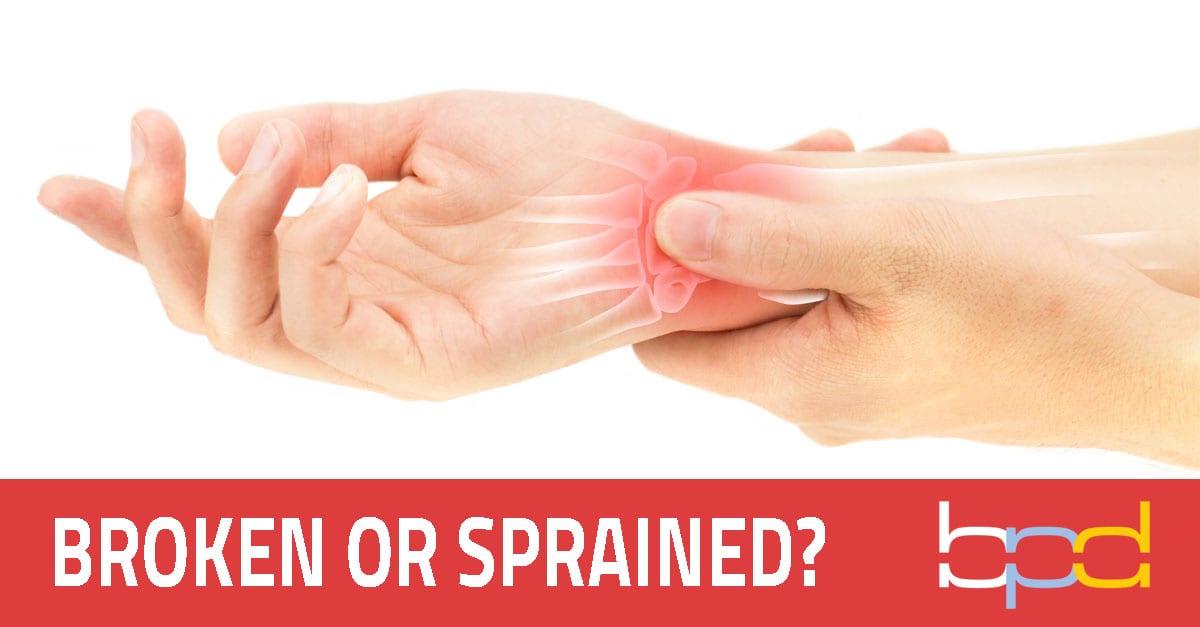Broken Wrist Or Sprained? Here's The Lowdown You Need To Know
So, you’ve taken a tumble, and now your wrist feels like it’s throwing a tantrum. Is it broken, or is it just sprained? This question can send you spiraling into a whirlwind of confusion and panic. But don’t sweat it—we’ve got your back! Whether it’s a broken wrist or sprained, understanding the difference is crucial for proper treatment. Let’s break it down, shall we?
Imagine this: you’re jamming out at a basketball game, and BAM—there goes your wrist after a not-so-elegant fall. Now you’re left wondering, “Is this serious?” or “Do I just need some rest?” The truth is, wrist injuries are no joke, and they’re more common than you think. In fact, wrist fractures and sprains account for a significant chunk of emergency room visits every year.
But here’s the thing: knowing whether you’ve got a broken wrist or a sprained one isn’t just about avoiding unnecessary drama—it’s about getting the right care. Whether it’s a fracture or a ligament tear, your wrist deserves the attention it needs. So, let’s dive into the nitty-gritty and figure out what’s really going on!
What’s the Deal with a Broken Wrist?
A broken wrist, or wrist fracture, happens when one or more bones in your wrist get cracked or shattered. The most common culprit? The radius bone, which is the larger of the two forearm bones that meet at the wrist. When you fall and instinctively reach out to catch yourself, the force can send your wrist into a world of hurt. And trust me, it’s not pretty.
Broken wrists often come with some telltale signs that you can’t ignore. Swelling, bruising, and pain are the usual suspects, but there’s more. If your wrist looks deformed or feels weak, it’s a red flag that something serious is up. And let’s not forget the inability to move your wrist properly—that’s a big hint too.
Types of Wrist Fractures
Not all broken wrists are created equal. Here’s a quick rundown of the main types:
- Colles Fracture: The granddaddy of wrist fractures, where the radius bone breaks near the wrist joint. It’s often accompanied by that characteristic “dinner fork” deformity.
- Smith’s Fracture: Think of it as the opposite of a Colles fracture. Instead of the wrist bending backward, it bends forward, leading to a broken radius.
- Scaphoid Fracture: This one hits the scaphoid bone, a small but mighty bone in the wrist. It’s notorious for being tricky to diagnose and heal.
Each type has its own quirks and challenges, but the bottom line is that a broken wrist needs prompt medical attention. Ignoring it can lead to long-term problems, like arthritis or chronic pain. Yikes!
Could It Be a Sprained Wrist?
Now, let’s talk about sprains. A sprained wrist happens when the ligaments—the tough bands of tissue that connect bones—get stretched or torn. Think of it like a rubber band that’s been pulled too far. Ouch!
Sprains come in different grades, depending on how severe the damage is:
- Grade 1: Mild sprain where the ligaments are stretched but not torn.
- Grade 2: Moderate sprain with partial tearing of the ligaments.
- Grade 3: Severe sprain where the ligaments are completely torn. This one’s a real doozy.
While sprains might not sound as scary as fractures, they can still pack a punch. Pain, swelling, and tenderness are common symptoms, and sometimes it’s hard to tell the difference between a sprain and a break. That’s why getting a proper diagnosis is key.
How to Tell the Difference
Alright, so you’ve got a sore wrist, but how do you know if it’s broken or sprained? Here’s the scoop:
- Pain Level: Broken wrists tend to hurt more, especially when you try to move them.
- Deformity: If your wrist looks funky or out of place, it’s likely a fracture.
- Swelling and Bruising: Both broken and sprained wrists can swell up, but fractures often have more bruising.
- Function: Can you move your wrist at all? If not, it might be broken.
Of course, the only way to know for sure is to see a doc. They’ll probably order an X-ray to get a clear picture of what’s going on under the surface.
Breaking Down the Diagnosis
When you visit the doctor, they’ll start by asking about your injury—how it happened, when it started, and what symptoms you’re experiencing. Then comes the fun part: the physical exam. The doc will gently poke and prod your wrist to check for tenderness, swelling, and range of motion.
If they suspect a fracture, it’s off to the X-ray machine. X-rays can reveal bone breaks, but sometimes fractures are sneaky and don’t show up right away. In those cases, your doc might recommend a follow-up X-ray or even an MRI to get a clearer picture.
What About Sprains?
Diagnosing a sprain is a bit trickier since X-rays won’t show ligament damage. Instead, your doc will rely on the physical exam and sometimes order an MRI to get a better look at the ligaments. It’s all about piecing together the puzzle to figure out what’s going on with your wrist.
Treatment Options for Broken Wrists
If your wrist is indeed broken, don’t worry—there are plenty of treatment options to help you heal. The first step is usually immobilization, which means putting your wrist in a cast or splint to keep it stable while it heals. Depending on the severity of the break, you might need surgery to realign the bones or insert pins, plates, or screws to hold them in place.
Recovery time varies depending on the type of fracture and how well you follow your doctor’s orders. Most people can expect to heal within six to eight weeks, but some fractures, like scaphoid fractures, can take longer. Physical therapy might also be in the cards to help restore strength and flexibility.
Treating Sprained Wrists
Sprains, on the other hand, usually respond well to the RICE method:
- Rest: Take a break from activities that strain your wrist.
- Ice: Apply ice packs to reduce swelling and pain.
- Compression: Wrap your wrist with a bandage to provide support.
- Elevation: Keep your wrist elevated to minimize swelling.
In more severe cases, your doc might recommend a wrist brace or even physical therapy to speed up recovery. And if you’re in serious pain, they might prescribe pain relievers or anti-inflammatory meds to help you feel better.
Preventing Wrist Injuries
Prevention is always better than cure, right? Here are some tips to keep your wrists safe:
- Wear Protective Gear: If you’re into sports or activities that put your wrists at risk, invest in good-quality wrist guards.
- Strengthen Your Wrists: Exercises that build wrist strength can make them more resilient to injury.
- Watch Your Step: Be mindful of uneven surfaces or slippery spots to avoid falls.
By taking these precautions, you can reduce your chances of ending up with a broken or sprained wrist. And let’s be real—who has time for that?
What to Do if You Suspect an Injury
If you think you’ve injured your wrist, the best thing you can do is seek medical attention ASAP. Ignoring it won’t make it go away and could lead to bigger problems down the road. In the meantime, follow the RICE method to keep the swelling and pain under control.
The Emotional Impact of Wrist Injuries
Let’s not forget the emotional side of things. Wrist injuries can be frustrating and limiting, especially if you’re used to being active or rely on your hands for work. It’s normal to feel a mix of emotions—frustration, anxiety, even sadness. But remember, you’re not alone. Thousands of people deal with wrist injuries every year, and most make a full recovery with the right care.
Talking to friends, family, or even a therapist can help you process your feelings and stay positive during the healing process. And hey, it’s a great excuse to binge-watch your favorite shows while your wrist takes a breather.
Staying Positive During Recovery
Recovery can be a rollercoaster, but staying positive is key. Focus on the progress you’re making, no matter how small, and celebrate each milestone. Whether it’s regaining a little more movement or finally getting that cast off, every step forward is worth cheering about.
Final Thoughts
So, there you have it—the lowdown on broken wrists versus sprained ones. Whether you’ve got a fracture or a sprain, the most important thing is to get it checked out by a professional. Ignoring the problem won’t make it go away and could lead to long-term issues.
Remember, your wrist is an essential part of your daily life, so treating it right is crucial. Follow your doctor’s advice, take care of yourself, and stay positive throughout the healing process. And if you’ve got questions or want to share your own experience, drop a comment below. Let’s keep the conversation going!
Table of Contents
- Broken Wrist or Sprained? Here's the Lowdown You Need to Know
- What’s the Deal with a Broken Wrist?
- Types of Wrist Fractures
- Could It Be a Sprained Wrist?
- How to Tell the Difference
- Breaking Down the Diagnosis
- Treatment Options for Broken Wrists
- Preventing Wrist Injuries
- The Emotional Impact of Wrist Injuries
- Final Thoughts



Detail Author:
- Name : Prof. Lawson Johns
- Username : freda09
- Email : zgleason@hotmail.com
- Birthdate : 1979-03-09
- Address : 759 Price Mountains Todstad, WY 25480
- Phone : (636) 746-9694
- Company : Kuphal, Weber and Gorczany
- Job : Tailor
- Bio : Omnis laudantium nesciunt id molestiae rem maxime. Ipsam sed dicta accusantium inventore praesentium aut. Maxime praesentium porro sed voluptatibus hic.
Socials
linkedin:
- url : https://linkedin.com/in/malvina_leffler
- username : malvina_leffler
- bio : Explicabo dolores libero est inventore quia.
- followers : 218
- following : 447
instagram:
- url : https://instagram.com/malvina.leffler
- username : malvina.leffler
- bio : Consequatur veniam aut ut ipsum voluptatem. Quia rerum qui quis corrupti.
- followers : 3177
- following : 259
tiktok:
- url : https://tiktok.com/@lefflerm
- username : lefflerm
- bio : Magni et ut nisi deserunt. Quisquam dolorem vitae ratione.
- followers : 4507
- following : 673
facebook:
- url : https://facebook.com/malvina_dev
- username : malvina_dev
- bio : Esse veritatis et aut qui voluptate similique minima.
- followers : 3838
- following : 2348